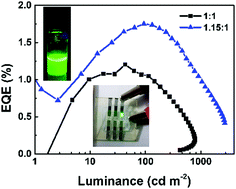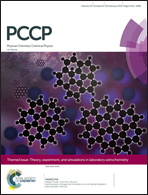Precursor non-stoichiometry to enable improved CH3NH3PbBr3 nanocrystal LED performance†
Abstract
High photoluminescence quantum yields and narrow emission wavelengths, combined with low temperature solution processing, make CH3NH3PbBr3 nanocrystals (NCs) favorable candidates for light-emitting applications. Herein, we describe the synthesis of CH3NH3PbBr3 NC inks by a convenient room-temperature ligand assisted reprecipitation protocol. We further investigate the effect of modulation of the CH3NH3Br : PbBr2 ratio during NC synthesis on the optical properties, crystallinity, particle size distribution and film formation of the NC ink. Subsequently, we fabricate LEDs using these NCs as the emissive layer and the highest efficiency (1.75% external quantum efficiency) and brightness (>2700 cd m−2) is achieved for the 1.15 : 1 precursor ratio. It is inferred that the NC surface properties and film coverage are more crucial than the photoluminescence intensity to achieve high device efficiency. Moreover, by separating the NC synthesis and thin film formation processes, we can exert more control during device fabrication, which makes it very promising for scale-up applications.



 Please wait while we load your content...
Please wait while we load your content...